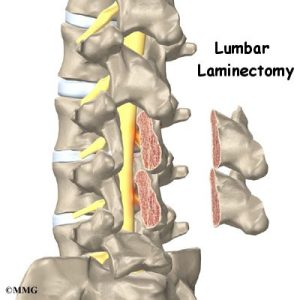 A surgical procedure that removes a portion of the vertebral bone, the lamina.
A surgical procedure that removes a portion of the vertebral bone, the lamina.
A surgical procedure that removes a portion of the vertebral bone called the lamina; which is the roof of the spinal canal.
The lamina is a posterior arch of the vertebral bone lying between the spinous process and the more lateral pedicles and the transverse processes of each vertebra.
The pair of laminae, along with the spinous process, make up the posterior wall of the bony spinal canal.
A conventional laminectomy in neurosurgery involves excision of the posterior spinal ligament and some or all of the spinous process.
Removal of these structures with an open technique requires disconnecting the many muscles of the back attached to them.
Minimal spinal surgery laminectomy procedure is a tissue-preserving surgery that leaves more of the muscle intact and spares the spinal process.
A laminotomy, is the removal of a mid-portion of one lamina and may be done either with a conventional open technique or in a minimalistic fashion.
A laminectomy is done to break the rigid ring of the spinal canal to allow the soft tissues within the canal to expand.
A laminectomy conventionally includes the removal of one or both lamina, other posterior supporting structures of the vertebral column, including ligaments and additional bone.
It can treat severe spinal stenosis by relieving pressure on the spinal cord or nerve roots, provide access to a tumor around the spinal cord, help contour the vertebral column to correct a spinal deformity, permit the removal or reshaping of a spinal disc as part of a lumbar discectomy.
It is a treatment for a herniated, bulging, or degenerated disc.
The recovery period depends on the operative technique, with minimally invasive procedures having significantly shorter recovery periods than open surgery.
Removal of extensive bone and tissue may require spinal fusion to stabilize the spine and generally require a much longer recovery period than a simple laminectomy.
Recovery time may be longer with spinal fusion.
Laminectomy and spinal fusion may take several months to return to normal activities.
Laminectomy and spinal fusion complications may include bleeding, infection, blood clots, nerve injury, and spinal fluid leak.
Laminectomy is performed most commonly to treat spinal stenosis.
Surgical treatment with laminectomy is the most effective management for severe spinal stenosis.
Most cases of spinal stenosis are not severe enough to require surgery.
With symptomatic spinal stenosis with neurogenic claudication and the laminectomy is done without spinal fusion, there is generally a rapid recovery and long term relief.
If the spinal column is unstable and fusion is required, the recovery period can last from several months to more than a year, and the likelihood of symptom relief is far less probable.
In most cases of laminectomy, patients tend to recover slowly, with recurring pain or spinal stenosis persisting for up to 18 months after the procedure.
In spinal stenosis surgery does not stop the degenerative process and symptoms may reappear within several years.
